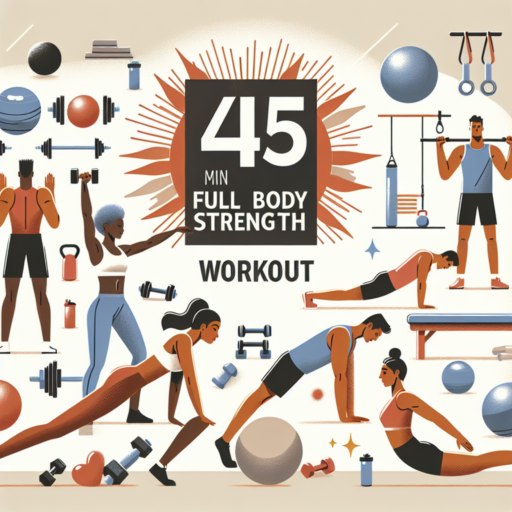Unlocking the Benefits of a Free Weight Workout Program
Engaging in a free weight workout program offers a multitude of benefits that can greatly contribute to one’s physical health and overall wellbeing. Unlike machines that often target specific muscles, free weights provide the advantage of engaging multiple muscle groups simultaneously, promoting functional strength and muscle coordination. This holistic approach to strength training can be particularly beneficial for enhancing daily movements and athletic performance.
Enhanced Muscle Balance and Coordination
One of the standout benefits of incorporating free weights into your workout routine is the significant improvement in muscle balance and coordination. Free weights compel the body to engage in a natural range of motion, necessitating the activation of both primary muscle groups and the stabilizing muscles. This not only leads to a more balanced muscle development but also enhances coordination and body awareness, which are crucial for performing complex movements both in and out of the gym.
Scalability and Versatility
Free weight workouts are inherently scalable and versatile, making them suitable for fitness enthusiasts of all levels. From beginners to advanced athletes, individuals can easily adjust the weight according to their strength and fitness goals. Additionally, the variety of exercises that can be performed with free weights is virtually limitless. Whether focusing on upper body, lower body, or full-body workouts, free weights offer the flexibility to customize and diversify your training program to keep it challenging and engaging.
Essential Equipment for Your Free Weight Workout Program
Embarking on a free weight workout program requires more than just motivation and a set of old dumbbells. To truly maximize your strength training and ensure safety, certain pieces of equipment are considered essential. These crucial items not only enhance your workout efficiency but also support your progression without compromising on safety.
Dumbbells and Barbells
The cornerstone of any free weight program is undoubtedly a good set of dumbbells and barbells. Dumbbells offer versatility and the ability to target specific muscle groups with precision, while barbells allow for heavier lifting, focusing on compound movements such as squats, deadlifts, and bench presses. Adjustable sets can be particularly useful, providing a range of weights without occupying the space that multiple fixed-weight dumbbells would.
Weight Benches
A quality weight bench is another indispensable piece of equipment. A bench supports exercises ranging from bench presses to dumbbell rows, expanding the variety of your workout routine. Flat, incline, and decline options further diversify your exercise catalog, ensuring that you can target all angles of muscle groups. Opting for an adjustable bench can offer the flexibility needed for a comprehensive full-body workout.
Safety Equipment
No free weight workout program is complete without considering safety equipment. Gloves and wrist wraps can protect against blisters and support your joints, while weight belts offer lower back support, especially during heavy lifts. Although often overlooked, these items are crucial for preventing injuries and enabling you to train consistently and effectively.
Step-by-Step Guide to Starting Your Free Weight Workout Program
Starting a free weight workout program can be both exciting and overwhelming for beginners. But with the right guidance, you can set yourself on the path to strength and fitness success. This guide will take you through the essential steps to get started, ensuring you build a solid foundation for your workout routine.
Choosing the Right Weights
The first step in your journey is selecting the appropriate weights. Beginners should start light, focusing on weights that allow for 12-15 repetitions with good form. It’s crucial to listen to your body and choose weights that challenge you without compromising your technique. Gradually increase the weight as your strength improves, but always prioritize form over heavier lifting to prevent injuries.
Creating a Balanced Routine
A well-rounded free weight program should target all the major muscle groups. Begin by dividing your workouts into upper and lower body sessions, ensuring each muscle group is worked 1-2 times a dispersar. Incorporating a variety of exercises, such as squats, deadlifts, presses, and rows, will help you develop strength evenly. Remember, consistency is key, so aim to maintain a regular workout schedule, gradually increasing the intensity and complexity of your exercises as you progress.
By following these initial steps, you’re laying down the groundwork for a successful free weight workout program. Paying attention to your body’s signals and being patient with your progress are essential components of your fitness journey. Begin with the end in mind, and enjoy the process of becoming stronger and more confident in your abilities.
Tailoring Your Free Weight Workout Program for Muscle Gain
Building muscle goes beyond just lifting heavy weights at the gym. A well-structured free weight workout program specifically designed for muscle gain is key to achieving your fitness goals. The process involves not only the right selection of exercises but also understanding the principle of progressive overload, recovery, and nutrition that complements your effort in the gym.
Customizing Your Exercise Selection
When it comes to muscle gain, not all exercises are created equal. Compound movements such as squats, deadlifts, bench presses, and rows should form the core of your program. These exercises work multiple muscle groups simultaneously, allowing you to lift heavier weights and thus, stimulate more muscle fibers. Additionally, incorporating isolation exercises can help to target specific muscles that may need more attention, ensuring a balanced and comprehensive muscle development.
Optimizing Workout Volume and Intensity
The right balance of volume (how many sets and reps) and intensity (how heavy you lift) is crucial for muscle growth. Generally, a range of 6-12 reps per set has been shown to be most effective for hypertrophy. However, this does not mean you should shy away from heavier sets with lower reps or lighter sets with higher reps, as variation in your program will prevent plateaus. Tracking your progress and gradually increasing the weight or reps is a fundamental aspect of progressive overload, which is essential for continual muscle gain.
Remember, tailoring your free weight workout program for muscle gain is a dynamic process that requires periodic assessment and adjustments. By focusing on compound movements, adjusting your volume and intensity, and incorporating variation, you will create a powerful foundation for building muscle. Employ these strategies within your routine and you’ll be on your way to sculpting a stronger, more muscular physique.
Maximizing Fat Loss with a Free Weight Workout Program
Embarking on a journey to maximize fat loss can significantly benefit from integrating a well-structured free weight workout program. Unlike machines, free weights simulate natural movements, demanding more from your body and thus, potentially increasing the amount of fat burned. This effective approach to weight loss hinges on understanding the distinct advantages that free weight exercises offer.
The Role of Compound Movements in Burning Fat
One of the cornerstone elements of using free weights is the reliance on compound movements. Exercises like squats, deadlifts, and bench presses, which involve multiple joints and muscle groups, are known for their high energy expenditure. Engaging in these movements can lead to more calories burned during and after the workout, owing to the phenomenon known as the afterburn effect or excess post-exercise oxygen consumption (EPOC). By incorporating compound lifts into your routine, you’re not just building strength but are also maximizing your body’s fat-burning capabilities.
Customizing Your Free Weight Routine for Enhanced Fat Loss
Creating a personalized free weight workout schedule is vital for those aiming to shed fat effectively. Adjusting factors such as weight, reps, sets, and rest periods can make a substantial difference in reaching your fat loss goals. For instance, a focus on high-intensity, low-rest workouts with moderate to high repetitions can stimulate metabolic stress, leading to increased fat oxidation. It’s important to remember that consistency and progressive overload—gradually increasing the weight or the number of reps—are key to continued improvement and avoiding weight loss plateaus.
Incorporating Core Strength in Your Free Weight Routine
Building core strength is a fundamental aspect of enhancing your free weight routine. A strong core not only helps in improving posture but also in executing various exercises with better form, leading to more effective workouts. When you integrate core strengthening exercises into your free weight regimen, you’re investing in a cornerstone of physical fitness that supports almost every movement your body makes.
One of the key benefits of concentrating on the core while engaging in free weight exercises is the promotion of muscle balance and stability. This focus ensures that all movements are powered by a strong center, reducing the risk of injury. Additionally, a robust core facilitates the engagement of other muscle groups, allowing for a more comprehensive workout.
To seamlessly blend core strength exercises into your free weight routine, start by incorporating specific movements that challenge your core stability while using free weights. These can include exercises like deadlifts, squats, and overhead presses, which inherently engage and fortify the core as you lift. Moreover, alternating these with targeted core exercises such as planks, bicycle crunches, and Russian twists can significantly enhance your overall training effectiveness.
Overcoming Plateaus in Your Free Weight Workout Journey
Reaching a plateau in your free weight workout can be both frustrating and disheartening. However, it’s a common part of any fitness journey. The key to overcoming these standstills is to understand why they occur and knowing the right strategies to push through them. Whether you’ve seen a halt in muscle gain, strength, or fat loss, there are proven methods to overcome these hurdles and continue progressing towards your goals.
Alter Your Routine: One of the primary reasons for hitting a plateau is the body’s adaptation to your current workout routine. Your muscles get used to the same exercises, rep range, and weights, leading to a decrease in growth and progress. To counteract this, consider changing your workout routine every 4-6 weeks. This change could involve altering the order of exercises, incorporating new movements, adjusting the number of reps and sets, or increasing the weights lifted. By introducing novelty, your muscles are forced to adapt again, reigniting growth and progress.
Vary Your Reps and Sets: Adjusting your rep and set scheme is another effective strategy to break through a workout plateau. If you’ve been focusing on heavy weights with lower reps, switch to a higher rep range with lighter weights for a period. This change not only challenges your muscles in a new way but can also improve muscular endurance and stimulate hypertrophy. Conversely, if you primarily do high-rep, low-weight workouts, increasing the weight and lowering the rep count can spur strength development and muscle gain.
Safety Tips to Follow During Your Free Weight Exercises
Engaging in free weight exercises offers a plethora of health benefits ranging from building muscle to enhancing flexibility. However, ensuring safety during these exercises is crucial to prevent injuries and maximize benefits. By adhering to several key safety tips, you can ensure a healthier, more effective workout routine.
Always Warm Up Before Lifting
One fundamental safety tip is to never skip the warm-up session before starting your free weight exercises. Warming up prepares your muscles and joints for the workout, significantly reducing the risk of strains and injuries. A simple 5 to 10-minute routine that targets the major muscle groups you plan to work on can make a significant difference.
Use Proper Technique and Posture
Maintaining proper technique and posture during your exercises is another critical aspect of safety. Incorrect form not only diminishes the effectiveness of your workout but also increases the likelihood of injuries. It’s advisable to start with lighter weights to master the technique. You may also consider getting guidance from a professional trainer, especially when trying out new exercises.
Paying attention to how you lift and re-rack your weights is equally important. Always lift with your legs, not your back, to avoid strain, and ensure you safely return the weights to their proper place to prevent accidents both for you and others around you.
How to Progressively Load in Your Free Weight Workouts
Progressively loading your free weight workouts is pivotal to enhancing muscular strength and endurance over time. This approach, known as progressive overload, involves incrementally increasing the weight, volume, or intensity of your workouts to challenge your muscles adaptively. Understanding how to effectively incorporate this technique can transform your training outcomes, promoting muscle growth and preventing plateaus.
Start with a Solid Foundation
Before diving into progressive loading, it’s crucial to establish a solid foundation in your weight training routine. Begin with weights that allow you to perform exercises with proper form and control. Mastering the basics ensures your muscles are adequately prepared for the increased demands of progressive overload. It’s not just about lifting heavier; it’s about lifting smarter to foster sustainable growth and reduce the risk of injury.
Increment Gradually
Incorporate progressive load by increasing the weights incrementally. A common guide is to add 2-5% more weight when you can comfortably complete the current weight for your target rep and set range. This gradual increase ensures your muscles are continuously challenged, encouraging strength gains and improvements in muscle size. However, progress is not linear; listening to your body and adjusting as necessary is key to a successful progressive overload strategy.
Aside from increasing weight, varying your routine’s volume and intensity can also significantly impact your muscle’s growth and endurance. Consider alternating your rep and set schemes or incorporating different exercise variations. These adjustments keep your workouts fresh and your muscles guessing, which is crucial for breaking through plateaus and advancing in your fitness journey.
Tracking Your Progress: Tips and Tools for Your Free Weight Workout Program
Understanding the Importance of Tracking
Tracking your progress is an essential aspect of any free weight workout program. It not only helps you in setting realistic goals but also in maintaining motivation throughout your fitness journey. By keeping a detailed record of your workouts, you can identify patterns, measure improvements, and pinpoint areas needing more focus. Whether your goal is to increase muscle mass, enhance strength, or lose fat, a systematic approach to tracking will guide you towards success.
Effective Tips for Progress Tracking
Initiating a habit of tracking can be simple but profoundly impactful. Start by setting clear, attainable goals and breaking them down into measurable components. For instance, aim to increase the weight you lift by a certain amount over a month or improve the number of repetitions in each set. Regularly noting down your exercises, weights, sets, and reps is vital. Additionally, documenting your body measurements and taking progress photos can provide a more comprehensive view of your advances.
Top Tools for Workout Tracking
- Workout Journals: Traditional yet effective, workout journals offer the simplicity of pen and paper, making it easy to record details of every session.
- Digital Apps: Numerous apps are specifically designed for fitness tracking, providing features such as exercise libraries, customizable workout plans, and progress graphs.
- Wearable Tech: Devices like fitness trackers and smartwatches can automatically record your workouts, track your heart rate, and even analyze your sleep, all of which contribute to a holistic view of your health and progress.










